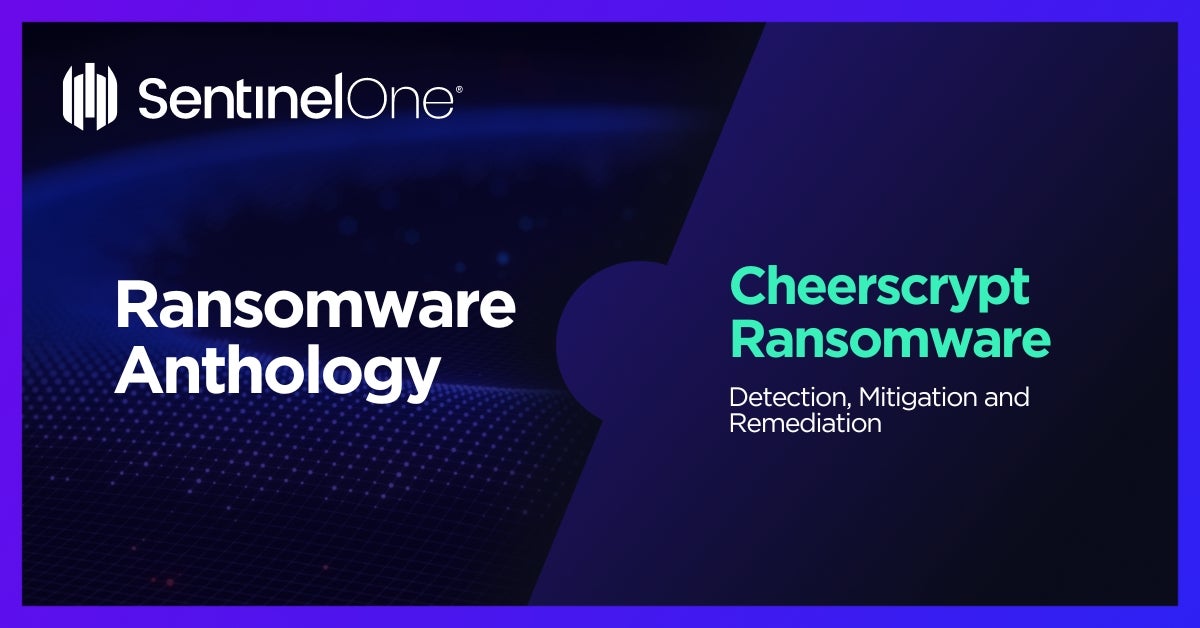Cheerscrypt Ransomware: In-Depth Analysis, Detection, and Mitigation
Summary of Cheerscrypt Ransomware
Cheerscrypt ransomware is a multiplatform ransomware family that emerged in May 2022. The Linux version of Cheerscrypt was launched followed by a Windows variant in June 2022. Cheerscrypt targets corporate networks and engages in multi- extortion – demanding payment for decryption tools, as well as for the non-release of stolen data. Early Linux variants specifically targeted VMWare EXSi environments. Cheerscrypt incorporates code from the leaked Babuk builders, and shares functionality with the Babuk family.

What Does Cheerscrypt Ransomware Target?
Cheerscrypt ransomware primarily targets the healthcare, financial services, entertainment, and education industries. Limited SMB (small to medium-sized businesses) targeting has been observed.
How Does Cheerscrypt Ransomware Spread?
Cheerscrypt ransomware is delivered via Cobalt Strike or similar framework. Cheerscrypt threat actors have also used the Log4Shell vulnerability to gain initial access to their target.
Cheerscrypt Ransomware Technical Details
In late May 2022, a Linux version of Cheerscrypt emerged, targeting VMware ESXi servers. This early-stage ransomware only requires a supplied encryption path to begin the encryption process. Cheerscrypt will also attempt to rename targeted files before encryption, and terminate any VMware-related processes for availability. However, if it does not have sufficient permissions to rename files, encryption may either fail or be avoided. Analysis of Cheerscrypt samples reveals it uses a combination of ECDH (Elliptic-curve Diffie-Hellman) and an embedded public key for encryption. The “.Cheers” extension is added to all encrypted files. The ransom note “How to Restore Your Files.txt” is written to every director containing encrypted files. Cheerscrypt actors have used commodity tools such as Impacket, Keylogger, NPS and IOX to assist in reconnaissance, lateral movement and data collection/exfiltration.
How to Detect Cheerscrypt Ransomware
- The SentinelOne Singularity XDR Platform can identify and stop any malicious activities and items related to Cheerscrypt ransomware.
In case you do not have SentinelOne deployed, detecting ransomware requires a combination of technical and operational measures designed to identify and flag suspicious activity on the network. This allows the organization to take appropriate action, and to prevent or mitigate the impact of the ransomware attack.
To mitigate the risk of this Ransomware without SentinelOne deployed, it is important to take a multi-layered approach, which includes the following steps:
- Use anti-malware software or other security tools capable of detecting and blocking known ransomware variants. These tools may use signatures, heuristics, or machine learning algorithms, to identify and block suspicious files or activities.
- Monitor network traffic and look for indicators of compromise, such as unusual network traffic patterns or communication with known command-and-control servers.
- Conduct regular security audits and assessments to identify network and system vulnerabilities and ensure that all security controls are in place and functioning properly.
- Educate and train employees on cybersecurity best practices, including identifying and reporting suspicious emails or other threats.
- Implement a robust backup and recovery plan to ensure that the organization has a copy of its data and can restore it in case of an attack.
How to Mitigate Cheerscrypt Ransomware
- The SentinelOne Singularity XDR Platform can return systems to their original state using either the Repair or Rollback feature.
In case you do not have SentinelOne deployed, there are several steps that organizations can take to mitigate the risk of ransomware attacks:
- Educate employees: Employees should be educated on the risks of ransomware, and on how to identify and avoid phishing emails, malicious attachments, and other threats. They should be encouraged to report suspicious emails or attachments, and to avoid opening them, or clicking on links or buttons in them.
- Implement strong passwords: Organizations should implement strong, unique passwords for all user accounts, and should regularly update and rotate these passwords. Passwords should be at least 8 characters long, and should include a combination of uppercase and lowercase letters, numbers, and special characters.
- Enable multi-factor authentication: Organizations should enable multi-factor authentication (MFA) for all user accounts, to provide an additional layer of security. This can be done through the use of mobile apps, such as Google Authenticator or Microsoft Authenticator, or through the use of physical tokens or smart cards.
- Update and patch systems: Organizations should regularly update and patch their systems, to fix any known vulnerabilities, and to prevent attackers from exploiting them. This includes updating the operating system, applications, and firmware on all devices, as well as disabling any unnecessary or unused services or protocols.
Implement backup and disaster recovery: Organizations should implement regular backup and disaster recovery (BDR) processes, to ensure that they can recover from ransomware attacks, or other disasters. This includes creating regular backups of all data and systems, and storing these backups in a secure, offsite location. The backups should be tested regularly, to ensure that they are working, and that they can be restored quickly and easily.